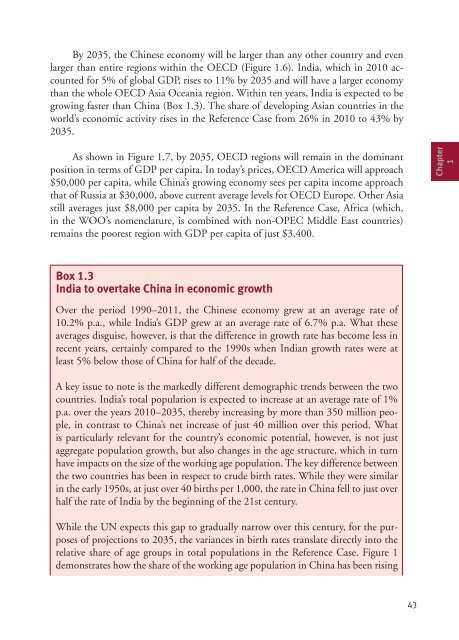World Oil Outlook - Opec
World Oil Outlook - Opec
World Oil Outlook - Opec
- TAGS
- world
- outlook
- opec
- www.opec.org
Create successful ePaper yourself
Turn your PDF publications into a flip-book with our unique Google optimized e-Paper software.
By 2035, the Chinese economy will be larger than any other country and even<br />
larger than entire regions within the OECD (Figure 1.6). India, which in 2010 accounted<br />
for 5% of global GDP, rises to 11% by 2035 and will have a larger economy<br />
than the whole OECD Asia Oceania region. Within ten years, India is expected to be<br />
growing faster than China (Box 1.3). The share of developing Asian countries in the<br />
world’s economic activity rises in the Reference Case from 26% in 2010 to 43% by<br />
2035.<br />
As shown in Figure 1.7, by 2035, OECD regions will remain in the dominant<br />
position in terms of GDP per capita. In today’s prices, OECD America will approach<br />
$50,000 per capita, while China’s growing economy sees per capita income approach<br />
that of Russia at $30,000, above current average levels for OECD Europe. Other Asia<br />
still averages just $8,000 per capita by 2035. In the Reference Case, Africa (which,<br />
in the WOO’s nomenclature, is combined with non-OPEC Middle East countries)<br />
remains the poorest region with GDP per capita of just $3,400.<br />
Box 1.3<br />
India to overtake China in economic growth<br />
Over the period 1990–2011, the Chinese economy grew at an average rate of<br />
10.2% p.a., while India’s GDP grew at an average rate of 6.7% p.a. What these<br />
averages disguise, however, is that the difference in growth rate has become less in<br />
recent years, certainly compared to the 1990s when Indian growth rates were at<br />
least 5% below those of China for half of the decade.<br />
A key issue to note is the markedly different demographic trends between the two<br />
countries. India’s total population is expected to increase at an average rate of 1%<br />
p.a. over the years 2010–2035, thereby increasing by more than 350 million people,<br />
in contrast to China’s net increase of just 40 million over this period. What<br />
is particularly relevant for the country’s economic potential, however, is not just<br />
aggregate population growth, but also changes in the age structure, which in turn<br />
have impacts on the size of the working age population. The key difference between<br />
the two countries has been in respect to crude birth rates. While they were similar<br />
in the early 1950s, at just over 40 births per 1,000, the rate in China fell to just over<br />
half the rate of India by the beginning of the 21st century.<br />
While the UN expects this gap to gradually narrow over this century, for the purposes<br />
of projections to 2035, the variances in birth rates translate directly into the<br />
relative share of age groups in total populations in the Reference Case. Figure 1<br />
demonstrates how the share of the working age population in China has been rising<br />
43<br />
Chapter<br />
1
















